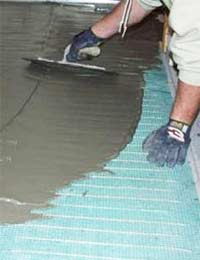
The push toward underfloor heating continues with designers and ecologist alike singing it’s praises. It’s expensive to install unless it’s part of a new build or complete re-fit though, so will lower utility charges eventually claw back the installation cost?
Contents
Checking out the Report
A report from the Underfloor Heating Manufacturers Association detailed the higher efficiencies possible with properly specified and installed underfloor heating and how the construction industry could make the best of it. We take a look at that report and its claims.
Underfloor heating can be up to 30% more efficient than radiators, creating opportunities for the construction industry as well as the domestic consumer.
Key Benefits of Underfloor Heating
Underfloor heating systems deliver significant carbon emission savings, especially when used in conjunction with renewable energy sources such as those employed by district energy schemes. Renewable heat sources are at their most efficient when they deliver the lowest possible temperature water to the heating system. Underfloor heating systems bring this temperature point down to between 30 and 40 degrees Celsius – significantly lower than conventional radiator-based central heating systems.
Although modern condensing boilers provide more efficient systems for the home, underfloor heating will still save on average 15% against a standard radiator system. These savings are consistent regardless of property usage and should feed into dramatically lowered utility charges.
No Radiators Brings Benefits Too
The radiant effect of underfloor heating means that air temperature can be maintained at one or two degrees lower than a room unevenly heated by radiators, which can also cause damage to soft furnishings or artwork positioned above. Cleaning is easier and decorating quicker and less frequently required, all of which can result in savings, although not directly affecting utility charges.
Without the need to accommodate radiators it becomes much simpler to furnish your rooms, as you can position your furniture anywhere you like. No need to worry about young children burning themselves – underfloor heating is unobtrusive and safe, making it the perfect choice for schools and residential homes for the elderly.
In buildings with high ceilings radiators cause heat to rise up and be lost. Underfloor heating warms only the lower part of the room, creating efficiencies and subsequently savings. As the heat dries liquids quickly the systems are idea for swimming pools and leisure centres, but this feature is also valuable in the domestic setting, particularly in bathrooms.
Planning Starts Early
Underfloor heating can be fitted in most floors, although it is prudent to consider it at the design stage. It is not simply the floor’s structure which is important, but the chosen finish; a few factors must be taken into consideration;
- Ceramic or stone floors will provide the most effective conduits, enabling the water temperature to be kept as low as possible.
- There’s no reason why you shouldn’t use underfloor heating systems with carpet, but restrict the tog rating to two, and select appropriate materials for your needs.
- If you have wooden floors and underfloor heating, it is essential that the floor temperature is capped at 27 degrees Celsius. With solid timber planks, the moisture content of the wood must be below 8% to avoid heat damage.
Long-Term Flexibility Because underfloor heating is designed to work on a 35 degree Celsius flow temperature they will remain workable systems in the event of a switch to renewable energy sources. With a radiator-based system this will cause a problem – the higher temperature demanded to support the system would be compromised by a change of source material.
Although an underfloor heating system is more expensive to install than traditional radiators, the pipework has a longer lifespan than standard radiators. Fitting underfloor heating is generally less than installing radiators and over the lifetime of a building the maintenance costs are significantly lower.
Conclusions
The report concludes that with soaring energy bills and increasing concern about the earth’s energy supplies, it pays to identify more efficient methods of heating your property. Underfloor heating provides an efficient and practical solution to keep you warm – at home or in the office – with lower utility charges to boot.




